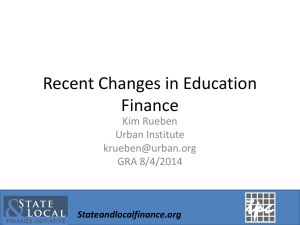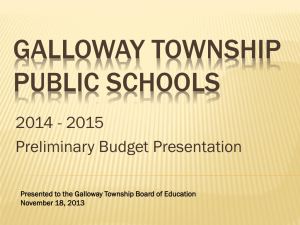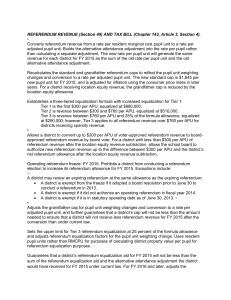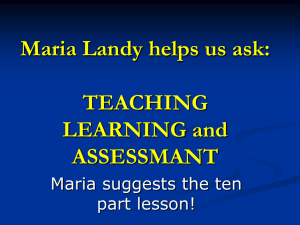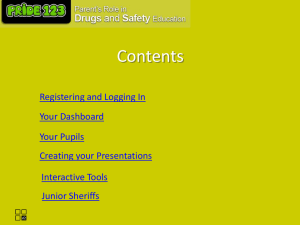Legislative Context and Session Update: Scott Croonquist
advertisement
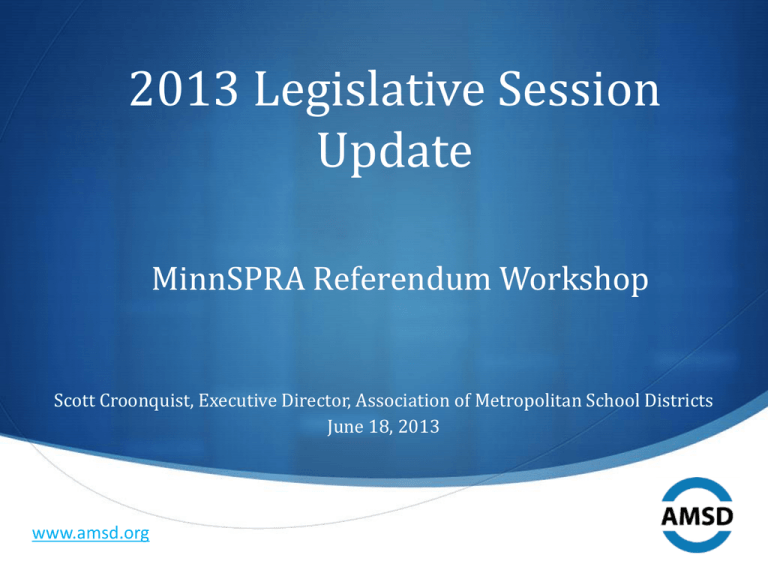
2013 Legislative Session Update MinnSPRA Referendum Workshop Scott Croonquist, Executive Director, Association of Metropolitan School Districts June 18, 2013 www.amsd.org 2013 Legislative SessionEducation Bill Summary Omnibus E-12 Education Act (Chapter 116) Highlights: • Bill spends $15.66 billion over the 2014-15 biennium - an increase of $485 million. • • • • • • • • $238 million formula increase (1.5 percent per year) $134 million for all day Kindergarten $40 million for early learning scholarships $40 million increase for special education $10 million increase to compensatory pilot grants $6.6 million for new assessments $3.5 million increase for safe schools levy $1.4 million for teacher growth and evaluation grants 2 2013 Legislative SessionEducation Bill Summary Pupil Weight Changes: Changes pupil unit weights as follows, beginning in FY 2015: Prekindergarten Disabled: Part-time Kindergarten: All-Day Kindergarten: Grades 1-3: Grades 4-6: Grades 7-12: from from from from from from 1.25 .612 .612 1.115 1.06 1.3 to to to to to to 1.0 .55 1.0 1.0 1.0 1.2 Referendum Revenue: Converts referendum revenue from a rate per resident marginal cost pupil unit to a rate per adjusted pupil unit. The new rate per pupil unit will generate the same revenue for each district for FY 2015 as the sum of the old rate per pupil unit. Recalculates the standard referendum cap to reflect the pupil unit weighting changes and conversion to a rate per adjusted pupil unit. The new standard cap is $1,845 per new pupil unit for FY 2015, and is adjusted for inflation using the consumer price index in later years. The grandfather cap is repealed. Going forward, the only districts that can exceed the standard referendum cap are districts that are eligible for sparsity revenue. 3 2013 Legislative SessionEducation Bill Summary Education Accounting Shifts: The 2013 Education Bill creates a one-time mechanism to accelerate repayment of the education accounting shifts. By September 30, the Minnesota Management and Budget Office is directed to use any state budget surplus as of June 30, 2013 to accelerate repayment of the shifts. The State enacted accounting shifts in 2009, 2010 and 2011 to balance the state budget. Following the 2011 special session, aid payment delays totaled over $2.1 billion and the property tax recognition shift totaled $600 million. Positive budget forecasts in February and November of 2012 and in February of 2013 have resulted in repayments of $1.9 billion leaving $801 million shifts to still be repaid. Important Note: Repayment of the accounting shifts does not result in any new revenue for school districts. Shift repayments simply mean that school districts will receive money they already had coming sooner. 4 2013 Legislative SessionLocation Equity Levy The location equity levy is established as a component of the general education program. The location equity levy recognizes labor cost differentials and enhances funding stability by moving referendum revenue to a new board approved levy. For a school district with any of its area in the seven-county metro area, the revenue equals $424 times the adjusted pupils for that year. For other school districts enrolling more than 2,000 students, the location equity levy level is $212 per pupil. Here again, it is important to note that the Location Equity Levy does NOT provide new revenue to most school districts. 5 2013 Legislative SessionReferendum Authority Effective in FY 2015, the first $300 of referendum authority is school board, rather than voter, approved. This applies to all school districts and guarantees that every school district has a minimum of $300 per pupil of referendum revenue. If a school district already had a referendum of $300 per pupil or more in place, this does NOT provide any new revenue. 6 2013 Legislative SessionEqualizing Factors Enhances the equalizing factors for referendum revenue. The bill establishes 3 tiers of referendum equalization: • Tier 1 – The first $300 per pupil is equalized at $880,000 of referendum market value per resident pupil unit. • Tier 2 – Referendum authority between $300 - $760 per pupil is equalized at $510,000 of referendum market value per resident pupil. This is also the equalization rate for the location equity levy. • Tier 3 - A district’s third tier referendum equalization allowance equals 25 percent of the formula allowance minus the sum of the first and second tier allowance and is equalized at $290,000 of referendum market value per resident pupil unit. 7 2013 Legislative SessionReferendum Freeze • Operating referendum freeze: Prohibits a district from conducting a referendum election to increase its referendum allowance for FY 2015. However, there are several exceptions: • • • • A district may renew an expiring referendum at the same allowance as the expiring referendum; A district is exempt from the freeze if it adopted a board resolution prior to June 30 to conduct a referendum in 2013. A district is exempt if it did not authorize an operating referendum in fiscal year 2014. A district is exempt if it is in statutory operating debt as of June 30, 2013. 8 Three Education Funding Facts: Inflation While the 2013 education bill contains significant reforms and funding, challenges remain: •Education funding has not kept pace with inflation over the past decade. Basic education revenue is the primary source of operating funds for school districts. Between 2003 and 2013, Minnesota’s basic per pupil funding formula increased from $4,601 to $5,224, an increase of 13.5 percent. During that same time period, inflation grew by 42.86 percent as measured by the Implicit Price Deflator (IPD) for state and local government purchases. In the 2013 Education Bill, the formula allowance is increased 1.5% each year. 2013: $5,224, 2014: $5,302, 2015 and later: $5,806 (adjusted for pupil weight changes). However, inflation is conservatively projected to rise 1.7% in FY 2014 and 1.6% in FY 2015. 9 Three Education Funding Facts: Special Education • The state is not paying for its mandated special education programming. For years school districts have had to divert general education aid and local operating levies to pay for mandated special education costs. Median sources of revenue for special education over fiscal years 2000 to 2011 were: 56 percent from state special education revenues, 33 percent from school districts’ general education and locally raised revenues, and 11 percent from federal revenues. The total special education cross-subsidy (the difference between total special education costs and state and federal special education revenue) for FY 2013 equals $614 million. 10 Three Education Funding Facts: Challenges • More students have more challenges than ever before. The number of students qualifying for free and reduced lunch, the number of English language learners and the number of students receiving special education services has risen dramatically. 11 State K-12 Free & Reduced Lunch 2003-2013 300,000 68,000 67,000 250,000 66,000 65,000 200,000 64,000 63,000 150,000 62,000 61,000 100,000 60,000 59,000 50,000 58,000 - 2003 2004 2005 2006 2007 2008 2009 2010 2011 2012 2013 Free Lunch 169,45 177,60 185,86 192,82 196,79 201,57 207,57 231,09 239,36 249,93 263,041 Reduced Lunch 62,380 60,766 61,784 61,334 62,979 63,339 65,997 65,806 66,930 61,935 60,703 12 57,000 State K-12 Limited English Proficiency 2003-2013 70,000 9.0% 8.0% 60,000 7.0% 50,000 6.0% 40,000 5.0% 4.0% 30,000 3.0% 20,000 2.0% 10,000 1.0% - 2003 2004 2005 2006 2007 2008 2009 2010 2011 2012 2013 Limited English Proficiency 52,357 54,988 58,815 59,197 63,858 62,903 63,776 63,381 64,131 64,623 65,689 % Limited English Proficiency 6.2% 6.5% 7.0% 7.1% 7.6% 7.5% 7.6% 7.6% 7.7% 7.7% 7.80% 13 0.0% State K-12 Special Education 2003-2013 130,000 15.5% 15.0% 125,000 14.5% 120,000 14.0% 115,000 13.5% 110,000 13.0% 105,000 12.5% 100,000 2003 2004 2005 2006 2007 2008 2009 2010 2011 2012 2013 Special Education 111,95 113,82 114,62 115,54 117,65 119,43 120,68 122,21 123,95 125,13 125,910 % Special Education 13.2% 13.5% 13.7% 13.8% 14.0% 14.3% 14.4% 14.6% 14.8% 14.9% 14.90% 14 12.0% Resources •Slides 2-4: Minnesota Education Bill, HF 630/Session Law Chapter 116, Available at: https://www.revisor.mn.gov/laws/?id=116&year=2013&type=0 •Slides 5-8: Minnesota Tax Bill, HF 677/Session Law Chapter 143 (Education provisions included in Article 3), Available at: https://www.revisor.mn.gov/laws/?id=143&year=2013&type=0 •Slides 9-14: AMSD Research and Statistics, Available at: http://www.amsd.org/research-statistics •Slide 10: Legislative Auditor Report on Special Education, Available at: http://www.auditor.leg.state.mn.us/ped/2013/sped.htm 15 Stay Connected with AMSD Web: www.amsd.org Twitter: @amsdmn Facebook: www.facebook.com/AMSDMN 16

